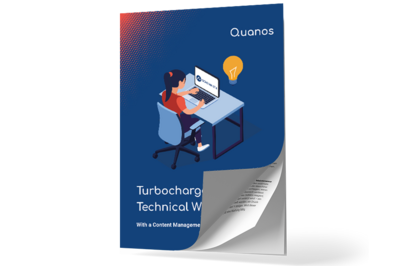How to Escape the Word Trap! Or: Why a Content Management System Makes Sense for Small Technical Writing Teams
You’ll often hear it said that an advanced content management system isn’t a worthwhile investment for small technical writing teams. Decision-makers tend to share this view, which leaves many small technical writing departments stuck in the Word trap. They continue pushing Word or InDesign to the limits, actually make things harder for themselves, and can barely stay on top of the all the tasks that come with a file-based way of working.

In this article you will learn about...
- ... three reasons why small technical writing teams in particular stand to benefit from powerful tools
- ... why small technical writing departments that opt for a CCMS can pay for the solution in under a year by saving on translations, text creation, layout, proofreading, and document provision
- ... why a content management system is definitely a worthwhile investment for small technical writing teams
Powerful tools actually do pay off for small technical writing departments in particular! Here’s three reasons why, plus a recommendation.
First reason: Because small technical writing departments are very productive
Small technical writing teams usually perform beyond expectation and are very focused on solutions. Otherwise, a technical writing team of just one or two members could never stay on top of the complex tasks involved in technical documentation at a typical company. Most small technical writing departments use this productivity to squeeze the last bit of efficiency out of their existing file-based solution. But taking their efficiency gains a couple of percentage points higher also means putting in a lot of effort for relatively small returns.
During implementation projects for our SCHEMA ST4 CCMS, we noticed the following two things:
First, system implementations in small technical writing departments are often especially straightforward and successful.
Second, these teams tend to really come into their own after the implementation because they’re not spending all their time focusing on “optimizing” their file-based approach. Rather, they are using the new opportunities available to them to boost efficiency and focus on the future.
Second reason: Because the knowledge in people’s heads becomes publicly available
Single-person technical writing departments, but also those slightly larger, have a surprising problem: These people know what they’re doing. This isn’t really unexpected, but it does become a problem when a member of the team isn’t there and can’t be reached. Now the company is missing the knowledge in people’s heads. However, there isn’t usually enough time to document this internal knowledge in everyday authoring work.
A CCMS helps to address this problem because it standardizes processes, structures data storage, and uses workflow components to document and automate key steps in the authoring process. This makes it easier for others involved in the process to see where the documentation is currently at and which content has been published, is publishable, or is being edited, even if they don’t have an extensive knowledge of the system. And the knowledge in people’s heads flows into the system (at least in terms of certain essential aspects).
Third reason: Cost is the deciding factor
Cost is the key factor in whether or not it makes sense for a small technical writing department to invest in a CCMS, and is often cited as a reason not to implement a system. But actually, this is thinking about it the wrong way, because documentation can involve substantial costs even for small technical writing departments. In many cases, a CCMS can pay for itself within a year thanks to the costs saved on translations alone. But a CCMS also saves on costs during the text creation, layout, proofreading, and document provision stages. In other words, cost is the deciding factor – in favor of a CCMS.
Conclusion
A component content management system (CCMS) is a worthwhile investment even for small technical writing teams, and can actually be especially beneficial in this case. Small technical writing departments that use a CCMS can boost their productivity by standardizing workflows, structuring data storage, and documenting and automating authoring processes. Plus, the knowledge in people’s heads becomes publicly available and the savings made on translations and other processes can pay for a CCMS within the first year.
Download our white paper

Small technical writing departments in particular often have to put together a very strong case to get approval for a CCMS. But small teams don’t really have the time for this alongside everything else they do on a daily basis. With this in mind, we would like to recommend our free white paper, which summarizes various benefits a CCMS can offer small technical writing teams, shares tips on preparing for budget negotiations, and includes a collection of progress reports from small technical writing departments that have already made the switch.


